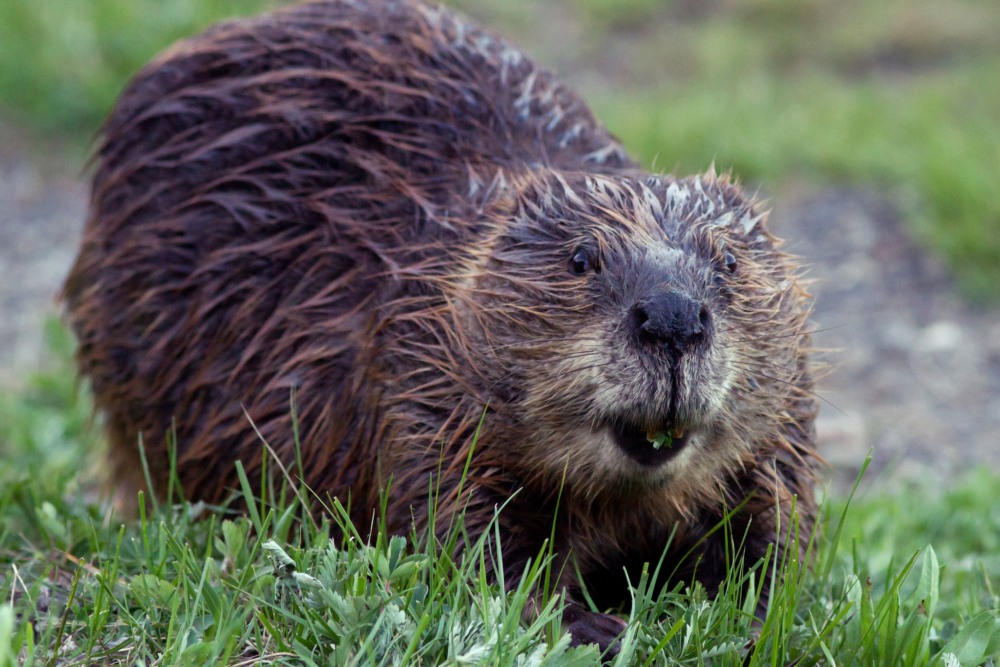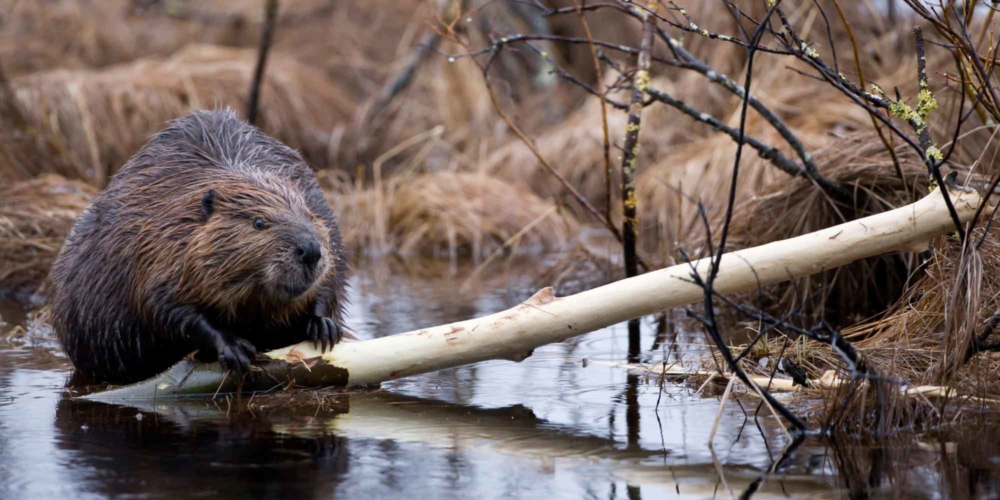Common beaver or river beaver (Castor fiber) - representative of the order of the Rodent. Together with the Canadian beaver, it is a member of the Beaver family. It is the second largest planet on the planet. Superiority - for capybara.
Material Content:
Description and features of an ordinary beaver
River beavers are semi-aquatic animals. The body of an adult animal is 100-130 cm in length, at the withers - 35-35.5 cm. Weight - about 32 kg. Males are slightly smaller than females. On the body there are 4 paired limbs, on each - 5 fingers with claws. The hind legs are more developed than the front legs. The membranes between the fingers help when swimming. They are only on the hind legs.
The tail is flattened and has an oily shape. Length - about 30 cm, almost 13 cm wide. Only the base is covered with wool. Keratinized skin with shields covers most of the tail. Between them are short nap. A keel runs through the middle of the tail.
The animals have small eyes and ears that do not protrude much from the fur. When immersed, the nasal and ear passages are closed, and the eyes are covered by the third eyelid. It is transparent.
The molars have no roots. The incisors are located at the back. The mouth is isolated from them by labial outgrowths. This makes it possible to bite right in the water.
The fur is original and beautiful. Under the coarse pile, there is a soft and thick layer of the underfill. Shedding begins before the summer and lasts until the end of autumn.
Color varies from light chestnut to dark brown. It is rarely almost black. The skin on the legs and tail are always black.
Under the tail are paired glands and a beaver stream. They produce a pungent secret. It contains information about the individual that left the label: age, gender. With this secret animals mark territory.
Due to the amazing fur and unique secret produced by the animal’s glands, the beavers were almost destroyed. In order to preserve their appearance, they were listed in the Red Book.
Habitat and habitat
These large rodents build huts with a special design. A distinctive feature is the entrance. It is always under water. The rodent digs a hole - this is a complex labyrinth in which there are several entrances. The ceiling and walls are leveled and carefully rammed. The construction of the hut begin in late summer. In finished form, it resembles a cone. The walls are covered with clay and silt. This strengthens the design. It is impregnable for many predators.
Beavers are the cleanest of mammals. They do not litter housing with uneaten feed and excrement.
On rivers where water changes level, animals build dams. This is necessary to maintain the first in one position. The framework for the dam is fallen trees. Animals surround them with other "building materials." Its length can be up to 30 meters, the width of the base - up to 6 meters, and the height - from 2 to 5 meters.
Beavers, so as not to be hungry, cut down trees. They also use them to build their houses and dams. They gnaw the trunks at the root. From a fallen tree, animals bite off the side branches, and the trunk is divided into parts.
To dump aspen 5-7 cm thick, you need 5 minutes. To dump a tree with a trunk diameter of slightly less than 50 cm, it takes only one night. Performing such work, they stand on the hind legs, and the tail serves as additional support. The work of the jaws is comparable to a saw. The incisors on the outside are coated with superhard dentin. They are self-sharpening.
Some of the branches are eaten immediately, the rest are dragged to a dwelling or a dam. During a long stay in one place, the animals trample the trails, which over time are filled with water and "beaver channels" are obtained. Their depth is sometimes up to 1 meter. Rodents fuse wood fodder along them. The terrain, which has undergone changes in the process of activity of these mammals, is called "beaver landscape".
Rodent nutrition
Beavers are semi-aquatic mammals, their diet consists only of plant foods. They prefer to eat willow and aspen, poplar, birch, and also grass plants like egg caps, water lilies, cattail, iris, and reed shoots. In total, the diet contains more than 300 items of plant food. The place where the beaver lives is due to the presence of trees with soft wood.
A minor place on the menu is occupied by linden bark, elm, hazel, bird cherry. Animals do not eat alder and oak, but are used only for construction. Beavers love acorns. Every day they should eat 20% of their own weight.
Large teeth and a strong bite allow rodents to eat plant foods of any hardness. Foods rich in cellulose are digested in the intestines due to the peculiar microflora.
Usually these animals eat wood of several species. When switching to other feeds, it takes time for the intestinal microflora to adapt to them. In spring and summer, the amount of grassy feed increases.
With the onset of autumn, animals begin to make winter stocks. They are placed in water. Thus, quality and nutritional value remain unchanged until February. One family procures up to 70 cubic meters of feed.
Breeding and offspring
Common beavers become sexually mature by the age of three. At the end of February, the race begins and lasts until April. Adults come out of wintering. They bathe in the wormwood, walk in the snow, leaving marks. Such a feature as a beaver stream is possessed by sexually mature animals of both sexes.
They usually mate in water. Pregnancy lasts 105-107 days. Usually in the litter there are 1-5 beavers. The number of cubs depends on how old the female is. Young give birth 1-2, and old - 3-4 cubs.
Plant feed in the diet of beavers is introduced from 3-4 weeks, and before that they feed on mother's milk.
At the age of 6-9 weeks, females stop feeding offspring with milk, because the youngsters begin to grow incisors and molars. Following their parents, they themselves go to the feeding place. In the second year of life, beavers become independent and can build their own hut.
The number in one family ranges from 1 to 10 individuals of various ages. But usually a family consists of a pair of adult animals and offspring over the past 2 years.
Natural enemies
Enemies of the beaver in natural nature:
- Wolves
- Wolverines
- foxes;
- Lynxes
- the Bears;
- stray dogs.
Small and weak cubs can be destroyed by owls, taimen or pike. Long-term observations have shown that otters do not harm beavers.
Economic value
From ancient times, the fur of this mammal was highly valued for its beauty. Also, the beaver stream is still valued. It is used in perfumery and medicine.
The meat of this large rodent is considered lean and is used as food. But today, their destruction for meat has declined significantly. They are carriers of salmonellosis - an intestinal infection that is dangerous to humans.
By the beginning of the 20th century, the population was on the verge of extinction; there were 1,200 individuals. Thanks to effective protective measures, in 1998 in Europe and Russia there were more than 430,000 individuals.
Interesting Facts
Among the interesting information:
- In the state of Montana, on the Jefferson River, these amazing animals built a giant dam. Its length was almost 700 meters.
- In the Middle Ages, they were classified as fish. This was done to eat meat in fasting.
- The ability to build a house is inherent in the genetic memory of mammals.
- Able to hold your breath for almost 15 minutes.
- Using the tail adjust the depth of immersion.
- The head of the family is the female - matriarchy.
Common beavers are distinguished by their high organization. Studying their habits, you can gather a lot of information that will be useful to people.
















